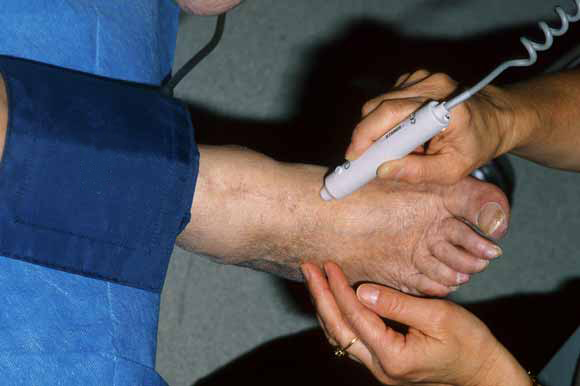Around 8 million people in the United States are reportedly suffering from peripheral arterial disease. It occurs due to stenosis and atherosclerosis in the vessels of the lower limbs which leads to decreased blood flow. The majority of people with the peripheral arterial disease are asymptomatic with severe disease characterized by pain during activity. As PAD is one of the leading indications for amputation, early detection and intervention is invaluable in limb salvage. The ankle-brachial index is an inexpensive, noninvasive diagnostic tool used by a variety of healthcare providers including podiatrists, wound care specialists, vascular surgeons, and specialist nurses.
What Is Ankle-Brachial Pressure Index?
The Ankle-Brachial Index was first described in the 1950s by Windsor. It is a non-invasive diagnostic modality that is used in screening and early diagnosis of peripheral arterial disease (PAD). It is a ratio between systolic blood pressure measured at the ankle and the systolic blood pressure measured at the arm. The comparison of blood pressures at these two points allows for the detection of stenosis in lower limb arteries. The stenosis of the vessels could be caused either due to atherosclerosis or compression from tissues. Even though there are slight variations in ABI (ankle-brachial index) depending on parameters like ethnicity, gender, and age, the overall reliability of ABI in the prediction of PAD is fairly consistent.
Although ABI is mainly used for the diagnosis of peripheral arterial disease, the ankle-brachial index can be helpful in monitoring wound healing and management of ischemic ulcers. In the setting of trauma, the ankle-brachial index can be helpful in the prediction of lower-limb arterial injury. To use ABI as a diagnostic tool, clinicians need to be aware of the normal values and classification of ankle-brachial index values. These include:
- Normal ABI: 0.9 to 0.13
- Mild ischemia: 0.8 to 0.9
- Moderate ischemia: 0.7 to 0.8
- Severe ischemia: 0.6 to 0.7
- Critical ischemia: Less than 0.5
Values less than 0.9 are diagnostic of peripheral arterial disease. As patients with these ABI values are at a higher cardiovascular risk, they should be referred for further investigations. Low ABI values are also associated with ischemic ulcers, and therefore a measurement of ABI values can be helpful for podiatrists and wound care specialists in monitoring wound healing.
How Is Ankle-Brachial Index Measured?
The ankle-brachial index is measured after the patient has rested for at least 10 minutes in a supine position. This position is preferred over the seated position as it helps to alleviate the hydrostatic pressure. The patient should not be on any sedative or anesthetic agent as it can affect the accuracy of ABI measurement. The BP cuff which is at least 40% of the limb circumference is inflated over the brachial artery in the upper arm. A Doppler ultrasound or a stethoscope is applied to the brachial artery to note the cessation of arterial blood flow. The method is repeated over the arm, and the highest of the two readings is used in the calculation of the ankle-brachial index.
For the measurement of ankle systolic blood pressure, the BP cuff is applied above the level of the malleoli and blood flow is detected in either the dorsalis pedis artery or the posterior tibial artery. The choice of artery depends on the artery with the highest systolic blood pressure. The process is repeated on the other leg, and the value obtained is used in the calculation of the ankle-brachial index.
Diagnosis of PAD Using Ankle-Brachial Index
According to the recommendations by American Heart Association, clinicians should evaluate patients for suspected peripheral arterial disease if they are over 50 with a history of smoking, or the age of 70. This is because the majority of patients with the peripheral arterial disease (PAD) have no symptoms at rest, and can benefit from early screening. This is corroborated with findings from a screening study that detected PAD in 50% of asymptomatic patients using the ankle-brachial index.
The ankle-brachial index can detect proximal stenosis better than the distal one, and is most reliable for the detection of 50% stenosis. Low ankle-brachial index values are also associated with increased risk of cardiovascular disease, stroke, and mortality. It should be kept in mind that the NICE UK guidelines do not recommend the use of the ankle-brachial index in diabetic patients as the measurements obtained can be unreliable due to stiffening of the arteries.
Contraindications To Measurement Of Ankle-Brachial Index
The ankle-brachial index is an excellent diagnostic tool for the evaluation and screening of peripheral arterial disease. It can also help predict the risk of amputation and can be used in wound care for monitoring the progression of ischemic ulcers. However, the presence of certain conditions can limit the application of the ankle-brachial index. These include:
- Deep Venous Thrombosis (DVT): The measurement of ankle-brachial index should be avoided in patients with suspected DVT according to the recommendations by American Heart Association. This is because there is a risk of embolization by compression with a BP cuff.
- Severe Pain: In the presence of severe leg pain, ABI measurements should be avoided. High pressure can be extremely uncomfortable for the patients and can aggravate the pain.



.webp)

.avif)